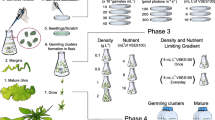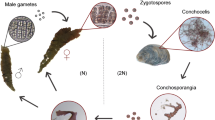Abstract
Currently, Gelidium and Pterocladia (Gelidiales) are collected or harvested only from the sea. Despite several attempts to develop a cultivation technology for Gelidium, no successful methodology has yet been developed. Initial steps towards developmental efforts in Portugal, Spain, South Africa and Israel have been published. More developments have probably been performed but have not been published. Two different technological concepts have been tested for Gelidium cultivation: (1) the attachment of Gelidium fragments to concrete cylinders floating in the sea, and (2) free-floating pond cultivation technology. These vegetative cultivation technologies might be partially optimized by controlling physical, chemical and biological growth factors. The pond cultivation technology is the much more controllable option. The effects of all factors are discussed in detail in this review. It seems that the main difficulty with cultivation of Gelidium is its low growth rate. The claimed yields of the two technologies are far from being economically attractive at this stage of their development. It seems that in order to introduce Gelidium into commercial cultivation, major efforts in genetic improvement through selection or genetic engineering will be required. Only high yield strains will have the potential to compete economically with the present harvesting tradition. However, accumulated experience with genetic improvement of other useful seaweed species suggests that this is possible.
Similar content being viewed by others
References
Aken ME, Griffin NJ, Robertson BL (1993) Cultivation of the agarophyte Gelidium pristoides in Algoa bay South-Africa. Hydrobiologia 268:169–178
Arrontes J (1990) Composition, distribution on host, and seasonality of epiphytes on three intertidal algae. Bot Mar 33:205–211
Boulus A, Spaneir E, Friedlander M (2007) Effect of outdoor conditions on growth rate and chemical composition of Gelidium crinale in culture. J Appl Phycol (in press)
Carmona R, Vergara JJ, Perez-Llorens JL, Figueroa FL, Niell FX (1996) Photosynthetic acclimation and biochemical responses of Gelidium sesquipedale cultured in chemostats under different qualities of light. Mar Biol 127:25–34
Fei XG, Huang LJ (1991) Artificial sporeling and field cultivation of Gelidium in China. Hydrobiologia 221:119–124
Gal-Or S, Israel A (2004) Growth responses of Pterocladiella capillacea (Rhodophyta) in laboratory and outdoor cultivation. J Appl Phycol 16:195–202
Givernaud T, Mouradi A (2006) Seaweed resources of Morocco. In: Critchley AT, Ohno M, Largo DB (eds) World seaweed resources. ETI Bioinformatics, Amsterdam
Hernandez-Guerrero CJ, Casas-Valdez M, Ortega-Garcia S, Hernandez-Vazquez S (2000) Effect of climatic variation on the relative abundance of the red alga Gelidium robustum in Baja California Sur, Mexico. J Appl Phycol 12:177–183
Juanes JA, Puente A (1993) Differential reattachment capacity of isomorphic life history phases of Gelidium sesquipedale. Hydrobiologia 260–261:139–144
Liu D, Pickering A, Sun J (2004) Preliminary study on the responses of three marine algae, Ulva pertusa (Chlorophyta), Gelidium amansii (Rhodophyta) and Sargassum enerve (Phaeophyta), to nitrogen source and its availability. J Ocean Univ China 3:75–79
Melo RA (1998) Gelidium commercial exploitation: Natural resources and cultivation. J Appl Phycol 10:303–314
Mercado JM, Carmona R, Niell FX (1998) Bryozoans increase available O2 for photosynthesis in Gelidium sesquipedale. J Phycol 34:925–927
Mercado JM, Niell FX, Gil-Rodriguez MC (2001) Photosynthesis might be limited by light, not inorganic carbon availability, in three intertidal Gelidiales species. New Phytol 149:431–439
Pacheco-Ruiz I, Zertuche-Gonzalez JA (1995) Effect of water movement on the growth of Gelidium robustum (Gardn.) Hollenb. and Abb. (Rhodophyta). Cienc Mar 21:59–70
Patwary MU, Van der Meer JP (1997) Construction of backcrossed Gelidium male- sterile and male-fertile lines and their growth comparison. J Appl Phycol 8:483–486
Pei L, Luo Q, Fei Z, Ma B (1996) Study on tissue culture for Gelidium seedling. Chin J Oceanol Limnol 14:175–182
Rodriguez D (1996) Vegetative propagation by fragmentation of Gelidium sclerophyllum (Gelidiales, Rhodophyta). Hydrobiologia 326–327:361–365
Rojas R, Leon NM, Rojas RO (1996) Practical and descriptive techniques for Gelidium rex (Gelidiales, Rhodophyta) culture. Hydrobiologia 326–327:367–370
Salinas JM (1991) Spray system for re-attachment of Gelidium sesquipedale (Clem.) Born. et Thur. (Gelidiales, Rhodophyta). Hydrobiologia 221:107–117
Salinas JM (1991a) El proceso de refijación en Gelidium sesquipedale (Clem.) Born. et. Thur. (Gelidiales: Rhodophyta). Bul Inst Esp Oceanogr 7:3–58
Seoane-Camba JA (1997) Gelidium sesquipedale cultivation in Galicia (Spain). Lagascalia 19:179–186
Shunzo S (1971) Mariculture of seaweeds and its problems in Japan. Proceedings of the First US–Japan Meeting on Aquaculture at Tokyo, Japan
Silva J, Santos R, Serodio J, Melo A (1998) Light response curves for Gelidium sesquipedale from different depths, determined by two methods: O2 evolution and chlorophyll fluorescence. J Appl Phycol 10:295–301
Sosa PA, Gomez- Pinchetti JL, Juanes JA (2006) The seaweed resources of Spain. In: Critchley AT, Ohno M, Largo DB (eds) DVD ROM. World Seaweed Resources. An authoritative reference system. ETI Information, Amsterdam, ISBN: 90 75000 80 4
Sousa-Pinto I, Lewis R, Polne-Fuller M (1996) The effect of phosphate concentration on growth and agar content of Gelidium robustum (Gelidiaceae, Rhodophyta) in culture. Hydrobiologia 326–327:437–443
Sousa-Pinto I, Murano E, Coelho S, Felga A, Pereira R (1999) The effect of light on growth and agar content of Gelidium pulchellum (Gelidiaceae, Rhodophyta) in culture. Hydrobiologia 398/399:329–338
Titlyanov EA, Titlyanova TV, Kadel P, Luning K (2006) Obtaining plantlets from apical meristem of the red alga Gelidium sp. J Appl Phycol 18:167–174
Author information
Authors and Affiliations
Corresponding author
Rights and permissions
About this article
Cite this article
Friedlander, M. Advances in cultivation of Gelidiales. J Appl Phycol 20, 451–456 (2008). https://doi.org/10.1007/s10811-007-9285-1
Received:
Revised:
Accepted:
Published:
Issue Date:
DOI: https://doi.org/10.1007/s10811-007-9285-1




